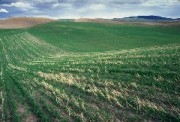| |
|
WHAT IS A
SCIENTIST?
What does the word Scientist
make you think of? Long white coats, a huge head of tangled hair,
screaming ". . . it's ALIVE!" On T.V., sure,
but in real life. . . not even close.
A scientist is a person who finds facts or organizes knowledge.
Scientists usually look like your mom or dad, but occasionally they look
like Bill Nye. To be a scientist takes training. Most scientists have at
least 20 years of education including their doctorate degree in a
specialized field of study. There are many different kinds of scientists
and different ways that they do their job. For example, a chemist may be a
scientist who works with the structures and properties of substances like
acids, while a botanist may be a scientist who works with living organisms
like plants.
Part of a scientist's job is to investigate any questions that anybody
might have. Recognizing a problem is the first step in science. Most scientists investigate problems by using The Scientific Method. This
method is made up of five steps that help scientists find answers. By
following these five steps, you too can be a scientist!
Most scientists investigate problems by using The Scientific Method. This
method is made up of five steps that help scientists find answers. By
following these five steps, you too can be a scientist!
The first step is to make an observation, which means to take a look at
the world around you and see what's going on. Then look for any problems,
or things you could make better and write them out (define a problem).
Next form a hypothesis or a really good guess at how you can fix the
problem. The fourth step is to test or experiment with your hypothesis to
see if it will work. If it doesn't, then make another guess and try it
again. Experiments, don't always solve problems, but they can show you
some new information that may help you find an answer. Lastly, take
everything you learned from your experiments and form a conclusion that
explains what you did, what worked, and what didn't. Sometimes scientists
find new things by accident, but more often they follow the Scientific
Method.
At the station, we have several kinds of scientists. For example:
 Agricultural
Engineer - designs machines to be used by other scientists and
farmers. Looks for ways to save soil so that it produces more crops. Agricultural
Engineer - designs machines to be used by other scientists and
farmers. Looks for ways to save soil so that it produces more crops.
 Microbiologist
- Works with microorganisms (things so small you need a microscope to
see them). Learns how they live and how they help plants and animals
live in their environment. Microbiologist
- Works with microorganisms (things so small you need a microscope to
see them). Learns how they live and how they help plants and animals
live in their environment.
 Hydrologist
- Studies water on land, in soil and under rocks. Learns how to manage
and conserve our water. Hydrologist
- Studies water on land, in soil and under rocks. Learns how to manage
and conserve our water.
 Soil
Scientist - Works with the soil in several ways. For example a soil
scientist may study the chemistry and fertility of soil. He may also
study water and how it moves through the soil. Soil
Scientist - Works with the soil in several ways. For example a soil
scientist may study the chemistry and fertility of soil. He may also
study water and how it moves through the soil.
These scientists, with the help of many other people at the station,
work together to improve soil and water management in the Pacific
Northwest.

|
|



 |


